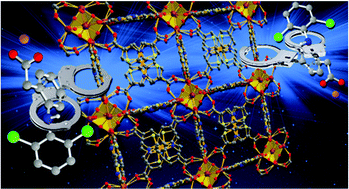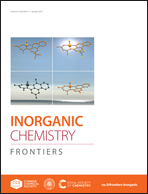UiO-67-derived bithiophene and bithiazole MIXMOFs for luminescence sensing and removal of contaminants of emerging concern in wastewater†
Abstract
Solvent-assisted ligand exchange in the zirconium metal–organic framework (MOF) UiO-67 [Zr6O4(OH)4(PhPh)6; H2PhPh = biphenyl-4,4′-dicarboxylic acid] with the heterocyclic linkers H2TpTp (2,2′-bithiophene-5,5′-dicarboxylic acid) and H2TzTz (2,2′-bithiazole-5,5′-dicarboxylic acid) in an equimolar [Zr6] : linker ratio led to the corresponding MIXMOFs UiO-67-TpTp [Zr6O4(OH)4(PhPh)5(TpTp)] and UiO-67-TzTz [Zr6O4(OH)4(PhPh)5(TzTz)]. Both MOFs have been thoroughly characterized in the solid state. They show the same structural topology and crystal structure of UiO-67, as confirmed by powder X-ray diffraction. Their BET specific surface area is lower than that of their parent material (1700 and 1310 m2 g−1 for UiO-67-TpTp and UiO-67-TzTz, respectively, vs. 1877 m2 g−1 for UiO-67), while the thermal stability of UiO-67 (Tdec = 819 K) is maintained. The “diluted” inclusion, in the UiO-67 3D framework, of luminescent heterocyclic linkers emitting in the blue-green visible region induces luminescence in the final MOFs (emission λmax = 442 and 420 nm for UiO-67-TpTp and UiO-67-TzTz, respectively), preventing self-quenching effects caused by the proximity of the emitters in the crystal structure. Both MOFs have been tested as sensors for contaminants of emerging concern (CECs) in water: an emission intensity increase has been observed when suspended in contact with diclofenac sodium, fluoxetine, ibuprofen and sulfamethoxazole. In particular, UiO-67-TzTz has shown a linearly increasing trend for a specific concentration range (up to 30–40 μM for diclofenac, fluoxetine and ibuprofen; up to 100 μM for sulfamethoxazole). UiO-67-TzTz also behaves as an adsorbent vs. diclofenac, with a maximum adsorption capacity (Xm) of 62.5 mg g−1. These findings pave the way to the practical utilization of UiO-67-TzTz as a multifunctional material (i.e. CECs luminescent sensor and adsorbent at one time) for environmental remediation.



 Please wait while we load your content...
Please wait while we load your content...